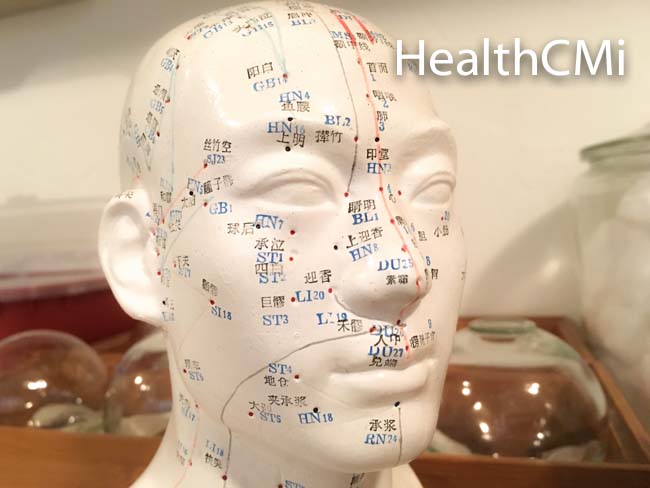http://www.healthcmi.com/Acupuncture-Continuing-Education-News/1638-acupuncture-beats-antidepressant-for-post-stroke-depression
Researchers find acupuncture more effective than an SSRI antidepressant medication for the treatment of post-stroke depression and prove that acupuncture combined with Chinese herbs are effective for stroke rehabilitation.
Researchers from Zhejiang Chinese Medical University and Hainan Provincial People’s Hospital finds acupuncture and traditional Chinese herbal medications effective in alleviating post-stroke conditions. The Xing Shen Jie Yu acupuncture method is effective in treating post-stroke depression; administering the herbal decoction Bu Yang Huan Wu Tang with acupuncture combats stroke sequelae. In both investigations, acupuncture treatment delivered significant positive patient outcomes.

Acupuncture is effective in treating post-stroke depression. Researchers from Zhejiang Chinese Medical University determined that a particular method of acupuncture, Xing Shen Jie Yu, which employs electroacupuncture, is more effective than standard medications in treating post-stroke depression. Post-stroke Depression (PSD) is a mental disorder that may present in post-stroke patients. Compared with patients without PSD, the depression that plagues PSD afflicted patients inhibits the speed of neurological rehabilitation after the stroke occurs. Consequently, PSD patients find it harder to regain a satisfactory level of independence and quality of life. Research has shown that the rate of PSD occurrence falls between 20 – 50% (Gaete and Bogousslavsky, 2008).
Xing Shen Jie Yu acupuncture is a characteristic method of acupuncture that was established by China’s renowned Traditional Chinese Medicine (TCM) doctor, Professor Wang Zhang Lian. The primary acupoints in Xing Shen Jie Yu are: Baihui, Shenting, Sishencong, Zusanli, Sanyinjiao and Taichong. The electroacupuncture technique utilized in Xing Shen Jie Yu significantly increases nerve and cerebral cortex stimulation, and produces a higher concentration of 5-HT and NE in brain tissue and cerebrospinal fluid.
The acupuncture classic Zhen Jiu Da Cheng (Great Compendium on Acupuncture and Moxibustion) dictates that the Governor meridian should be targeted in the treatment of brain illnesses; the Baihui and Shenting acupoints are both located along this meridian. Administering acupuncture on these acupoints can improve qi and blood circulation along the Governor meridian, reinforce the Yang element, and fight depression. It is worth noting that the Baihui, Shenting and Sishencong acupoints are located on the frontal lobe surface projection zone. Therefore, acupuncture administration on these acupoints increases neuronal excitability as well as neurotransmitter secretion. The Zusanli acupoint also regulates qi and blood circulation in addition to dredging the meridians. The Taichong acupoint has a tranquilizing effect. The Sanyinjiao acupoint is a major acupoint for maintaining and improving spleen, liver and kidney health.
In the study conducted by researchers at Zhejiang Chinese Medical University, patients who received Xing Shen Jie Yu acupuncture reported a 93.33% total treatment effective rate, whereas those in the control group reported a 90% rate. The Xing Shen Jie Yu acupuncture group also displayed better performance in daily living activities performance. This research studied 60 PSD patients who were divided into two groups, the treatment group and the control group. The treatment group underwent Xing Shen Jie Yu acupuncture and the control group received citalopram medication. Citalopram is an antidepressant of the selective serotonin reuptake inhibitor (SSRI) class. Both groups received standard post-stroke treatments including blood pressure, blood glucose, and blood lipid regulation, as well as rehabilitation.
The acupoints used for the treatment group include the primary acupoints in Xing Shen Jie Yu acupuncture:
- Baihui (GV20)
- Shenting (GV24)
- Sishencong (EX)
- Zusanli (ST36)
- Sanyinjiao (SP6)
- Taichong (LV3)
- Jiache (ST6)
- Dicang (ST4)
- Yinxiang (LI20)
- Lianquan (CV23)
- Tongli (HT5)
- Jianyu (LI15)
- Quchi (LI11)
- Shousanli (LI10)
- Waiguan (TH5)
- Hegu (LI4)
- Houxi (SI3)
- Huantiao (GB30)
- Futu (ST32)
- Yanglingquan (GB34)
- Yinlingquan (SP9)
- Xuanzhong (GB39)
- Jiexi (ST41)
For the Baihui acupoint, the needle was inserted transversely and posteriorly between a depth of 0.5 – 0.8 inches, thereafter manipulating it with a rotating (Nian Zhuan) technique at a speed of 200 rotations/minute, for a total of 2 minutes. For the Sishencong acupoints, the needle was inserted transversely and towards the Baihui acupoint, between a depth of 0.5 – 0.8 inches. The front Sishencong acupoint was paired with the left Sishencong acupoint, and the back Sishencong acupoint with the right Sishencong acupoint. Both pairs of acupoints were then connected to Han’s Acupoint Nerve Stimulator with 100 Hz frequency. After the area surrounding the acupoints displayed visible pulsing, and patient comfort was optimal, the Han’s Acupoint Nerve Stimulator was used to apply electroacupuncture stimulation for 30 minutes. For the Shenting acupoint, the needle was inserted transversely and anteriorly between a depth of 0.5 – 0.8 inches, thereafter manipulating it with a rotating (Nian Zhuan) and reinforcing (Bu) technique at a speed of 200 rotations/minute, for a total of 2 minutes. For the Zusanli acupoint, the acupuncture needle was inserted perpendicular-obliquely, towards the direction of the tibia, between a depth of 1 – 2 inches, with the reinforcing (Bu) technique. For all acupoints, the needle retention time was 30 minutes. An acupuncture session was conducted once daily, 6 times per week, with a 1 day break between weekly sessions. A full treatment course comprised 30 days of acupuncture sessions.
For the control group, patients took one 20 mg citalopram tablet per day, after breakfast. A full medication course comprised 30 continuous days. The treatment effective rate for all patients in the study was evaluated based on the Hamilton Depression Scale rating, and categorized as follows:
- Recovery: Rating reduction of at least 75%.
- Significantly effective: Rating reduction of at least 50%.
- Effective: Rating reduction of at least 25%.
- Ineffective: Rating reduction of less than 25%.
No comments:
Post a Comment